
Viewability
Viewability measures the likelihood of your target audience viewing your ad placements. It indicates whether an ad is seen by a user rather than simply being loaded on a website or mobile app.
What is viewability?

Viewability is crucial for you as an advertiser — it determines whether users actually see your ad placements. It’s a metric that measures the likelihood of your ads being noticed by those visiting websites or apps.
Note that viewability is not the same as impressions.
Traditionally, an ad impression is counted whenever an ad is served onto a webpage, regardless of whether the user actually sees it. Think of it like those flyers left on your doorstep — just because they’re there doesn’t mean you’ve read them.
With viewability metrics, you can ensure your ads aren’t just loaded but also seen by users. Viewability is typically measured as a percentage, indicating the portion of ad impressions meeting certain criteria for being considered “viewed.”
So, what are these criteria?
Ad visibility criteria
According to the Interactive Advertising Bureau (IAB), an ad is considered viewable if it meets the following criteria regarding its visibility on the user’s screen:
- For display ads: At least 50% of the ad’s pixels are in view on the user’s screen for a minimum of one second. This means more than half of the ad must be visible within the specified time frame to count as viewable.
- For video ads: At least 50% of the ad’s pixels are in view on the user’s screen for a minimum of two consecutive seconds, as video ads may need a bit longer to capture the user’s attention.
These criteria ensure you’re paying for ad impressions more likely to be seen.
By setting minimum viewability thresholds, you can gauge ad placement effectiveness and plan your advertising strategies wisely.
Keep in mind that viewability standards may vary slightly across industries or specific advertising platforms, with different SSPs using different measurements.
For example, for large-size creatives (display ads sized at 242,500 pixels or more), Xandr and OpenX consider an ad viewed when 30% of the creative is visible for one second. Nonetheless, the IAB’s guidelines are widely accepted as a benchmark for measuring viewability in digital advertising.
How to measure viewability
Measuring viewability involves comparing the number of ad impressions that meet the viewability criteria to the total number of ad impressions measured.
To calculate viewability, use the following formula:
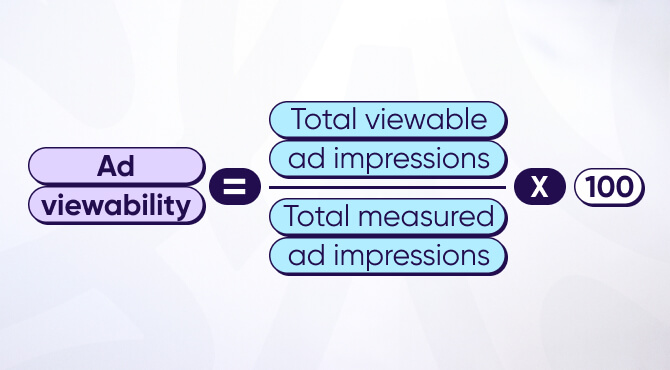
Let’s break that down:
- Total viewable ad impressions: The number of ad impressions that meet the criteria for being considered “viewed.” These impressions are typically counted based on whether a certain percentage of the ad’s pixels are in view for a specified duration (for example, at least 50% of pixels visible for one second for display ads).
- Total measured ad impressions: The total number of ad impressions that were measured, regardless of whether they met the criteria for viewability.
You multiply by 100 to obtain a percentage.
Here’s an example to bring it to life:
Suppose you ran an ad campaign and measured 10,000 ad impressions in total. Out of these, let’s say 6,000 ad impressions met the criteria for being viewable.
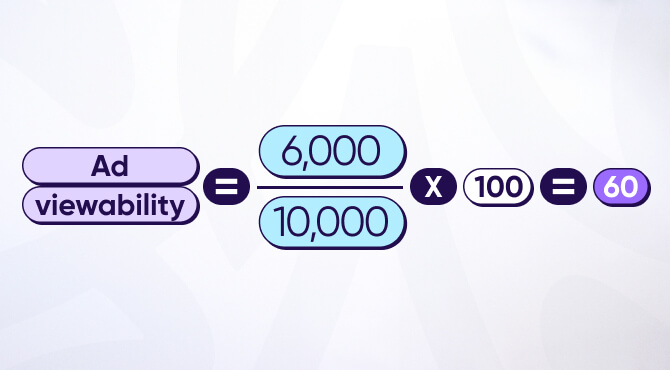
Here, your ad campaign’s viewability is 60%. This means that 60% of the measured ad impressions were viewable according to the specified criteria.
Measuring visibility benefits both advertisers and publishers

Viewable impressions give you, the advertiser, insights into how well your ads are being seen by users.
At the same time, they help publishers ensure your ads are displayed correctly to their audience. Here’s how they generally measure it:
1 — Measurement based on ad container
Some measurements focus on the ad container rather than the ad itself. So, if the container meets certain criteria (like having at least 50% of its pixels in view for a set time), the ad is counted as viewable.
However, this can be tricky because it doesn’t guarantee that users saw your ad. For instance, if your ad is at the bottom of a webpage and a user never scrolls down, they may miss your ad altogether, even if the container is visible.
2 — Measurement based on the ad itself
Other methods focus directly on the ad. They measure if a certain percentage of the ad’s pixels are visible for a set time. This gives a clearer picture of whether users actually see your ad.
Both methods have their pros and cons, but most advertisers like focusing on the ad itself. After all, you want to ensure your ad content is actually seen by users. It’s also useful for publishers, helping them offer high-quality ad placements that benefit both advertisers and their audiences.
Which viewability KPIs should you measure?

1 — Ad calls/Ad requests
Ad calls, also known as ad requests, indicate how many times an ad is displayed on a page during a user’s session. While ad calls don’t guarantee views of your ad, they show the opportunities for impressions.
2 — Average viewable CPM
Average viewable CPM is the average cost for 1,000 viewable impressions (the M stands for mille, which is Latin for thousand). It shows how much you’re paying for impressions actually seen by users, excluding those that weren’t viewed.
3 — Active View
Provided by Google, Active View is a tool that helps publishers measure and report on viewability. It’s native to Google Ad Manager, AdSense, and AdMob.
4 — Burned budget
Burned budget shows how much of your ad spend has been used to buy ads that weren’t seen by your audience — essentially wasted money.
5 — Measurable cost
Measurable cost is the total cost of all ad impressions that were measured. It helps you see how much of your budget went towards impressions you could keep tabs on.
6 — Measurable impression
Measurable impression is the number of ads served that your reporting tool was able to measure.
Note: Not all impressions can be measured — factors like technical issues, ad blockers, or certain types of ad placements can all prevent measurement. Knowing how many impressions you can measure compared to those served helps you understand how reliable your ad performance data is.
7 — Measurable rate
Measurable rate refers to the percentage of impressions your reporting tool was able to measure, out of the total impressions served.
8 — Viewable CTR
Viewable CTR measures the number of clicks on viewable impressions. It shows the engagement of visitors with viewable ads (ads that were seen).
9 — Viewability rate
Viewability rate is the percentage of impressions that qualify as viewable. It indicates how many impressions were seen by users.
10 — Viewable impression distribution
The viewable impression distribution metric shows the percentage of both measurable and non-measurable impressions that were seen by users. It helps you understand how viewable impressions are spread across your ad campaign, so you can better optimize placements and strategies for better visibility
Why is viewability important?
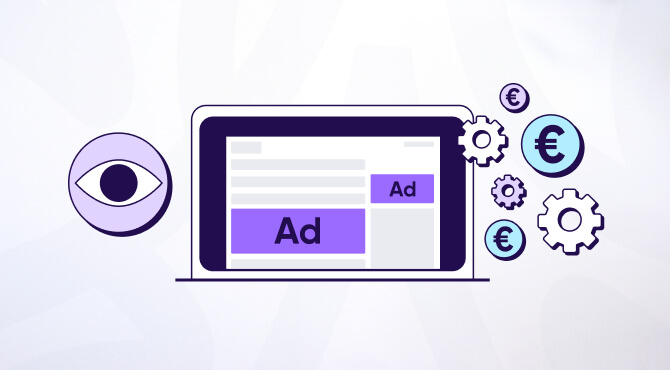
Tracking viewability is crucial for both advertisers/marketers and publishers.
- From the advertiser’s/marketer’s perspective, viewability ensures ad placements are actually seen by real human users.
Without viewability metrics, you might be paying for ad impressions that are not being viewed, essentially wasting your ad budget. In contrast, when you bid on viewable inventory, you can improve return on ad spend (ROAS) and ensure you’re getting the best possible value for your investment.
What’s more, viewability allows you to measure ad performance more accurately and optimize campaigns accordingly, leading to higher conversions.
- From the publisher’s perspective, viewability is useful for maximizing ad revenue.
While some publishers initially feared the shift to viewability-based payments would lose them revenue, others saw the opportunity to position their inventory as premium and command higher bids. With high-viewability ads becoming more important, viewable CPM (vCPM) might replace the old standard, CPM.
Additionally, understanding and tracking ad viewability metrics helps publishers boost their ad revenue. They can offer advertisers better placements, making sure ads are seen by users. This keeps advertisers happy and helps build long-term partnerships.
How to improve your viewability score
1 — Create and offer quality, relevant content
Quality content that resonates with your target audience has a twofold effect: it attracts and engages the viewer.
So, make sure to conduct thorough audience research to better understand your target user’s preferences, pain points, and interests. Additionally, tailor your content to provide value and relevance, whether it’s through informative articles, entertaining videos, or compelling graphics.
All this encourages users to spend more time on your webpage, leading to boosted ad visibility.
2 — Improve ad position
Aim for prime ad placements that maximize visibility. For instance, Google found that above-the-fold (ATF) video ads have a 73% viewability score on average, compared to 45% for below-the-fold (BTF) ads.
How do you identify the best positions? Conduct A/B tests to identify the most effective ad placements based on user engagement metrics.
You can also consider implementing dynamic ad insertion techniques that optimize ad placement in real-time based on user behavior and content relevance.
Then monitor and adjust your ad positions regularly to capitalize on high-performing placements and improve overall viewability.
3 — Use appropriate ad sizes

Ad size is another factor that directly impacts visibility and engagement.
Larger formats command more attention and have a higher viewability score. Case in point: A 2560 x 1440 video player has a 95% viewability rate, whereas an 854 x 480 player size has an 88% viewability rate.
However, you must strike a balance between size and user experience.
Avoid oversized ads that detract from content readability or disrupt the user journey. Instead, use ad sizes that complement the web page or app layout and seamlessly integrate with the surrounding content.
A good tip is to conduct usability testing to evaluate the impact of different ad sizes on user experience and adjust accordingly.
4 — Ensure faster loading times
Any website with ads that take longer to load negatively impacts ad viewability. This holds true even if the website itself is fast.
So you should optimize ad creatives and landing pages to minimize loading times across various devices and network conditions.
You can do this by:
- Compressing images, streamlining code, and using caching techniques to reduce latency and improve page load speed.
- Prioritizing lightweight ad formats that load quickly without compromising visual quality.
- Reducing passbacks to decrease the number of ad calls between servers. Fewer ad calls lower page latency and boost ad viewability.
Another effective option is implementing lazy loading for BTF ads. This defers loading non-essential ad content until the user is most likely to see it. No point in implementing lazy loading for ATF banners, as you want them to upload right away for users.
5 — Optimize for different channels and devices
Users see your ads across multiple channels and devices, so it’s crucial to optimize the experience for each one.
To start, adopt a responsive design approach that renders ads seamlessly across devices, including desktops, smartphones, and tablets. Then customize creatives and formats to suit each platform’s unique characteristics and the user behavior associated with it.
In addition, leverage advanced targeting capabilities. This way, you can deliver personalized ads based on device type, location, demographics, and browsing history.
Finally, continuously monitor cross-channel performance metrics and iterate your performance optimization strategies to enhance viewability across all touchpoints.
6 — Place above-the-fold content strategically
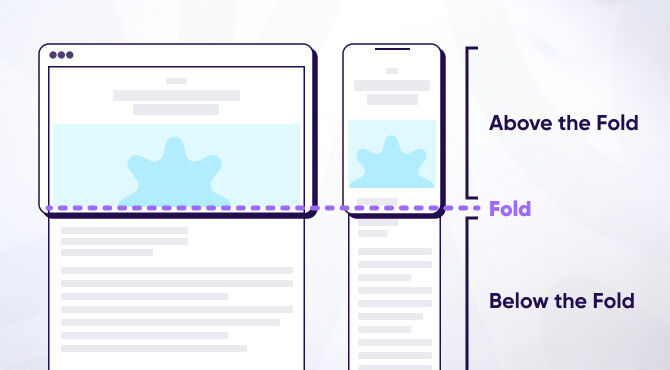
While top-of-page placements may seem prime, they often suffer from “banner blindness” as users habitually scroll past them.
That’s why we recommend focusing on the “scroll zone,” which refers to the area just below the top. Place your ads strategically within content or at mid-page positions, where users engage more actively, leading to higher viewability rates.
7 — Optimize your header bidding stack
Optimizing your header bidding stack involves strategically managing the order and setup of your header bidding partners.
The first step? Dig into the details of each seller’s performance data. Look and prioritize for partners who consistently bring in high-quality ad placements that are actually seen by users.
Next, keep refining your bidding strategy based on what’s happening in real-time. Adjust the prices you’re willing to pay and the order in which you let partners bid to make sure you’re getting the most out of each ad placement.
8 — Use stick ads (when appropriate)
Stick ads, also known as sticky ads or persistent ads, remain fixed in a specific position on the screen as users scroll through content. Like this:
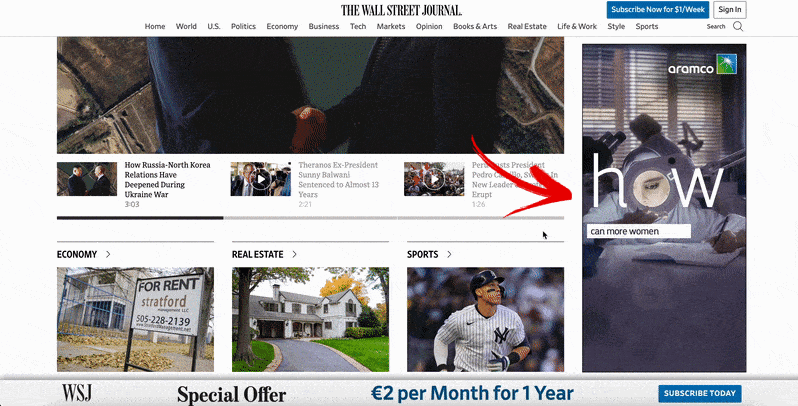
When used correctly, stick ads significantly improve viewability by ensuring your ad remains visible to users for an extended period.
But take care not to compromise user experience in your quest for maximum viewability.
Overusing these ads can lead to ad fatigue and user annoyance, ultimately undermining the effectiveness of your advertising strategy. So, test stick ads thoroughly to find out the best timing, position, and length. Make sure they blend well into the user’s journey.
9 — A/B test to improve viewability
A/B testing involves comparing two or more versions of an ad or webpage to determine which one performs better in terms of viewability.
But the whole process isn’t just about tweaking colors or headlines. It’s also about understanding the best ways to make an impression on your audience. Look at the results to refine your advertising approach and optimize for maximum viewability over time.
When doing A/B tests, analyze the data thoroughly to grasp how users interact with various ad styles, positions, and creative options. Don’t be afraid to try out new ideas to grab and retain users’ attention.
10 — Only refresh ads that pass viewability criteria
Ad refreshing, or ad refresh, is the practice of dynamically reloading ads within a web page or app after a set time to increase impressions. However, this can be a double-edged sword.
While ad refreshing can boost ad numbers, it also makes it tricky to know if people are actually viewing them. To navigate this issue, your best bet is to take a strategic approach.
Only refresh ads that have already met your viewability standards during their first display. This way, you prioritize quality over quantity, ensuring that ad impressions aren’t wasted on placements that aren’t viewed. Instead, you focus on serving ads that have a higher chance of being seen by users.
Challenges for measuring viewability

When you start optimizing viewability, be prepared for the following challenges:
- Ad fraud: Sophisticated fraudulent techniques, like making fake traffic look real (impression laundering) or using bots to fake views (bot traffic), fool the tools that measure ad views. This makes it seem like more people are seeing the ads than they really are, tricking advertisers and publishers.
- Poor ad placement: Ads may end up in less visible areas of a webpage due to factors like page layout or user behavior. This makes it hard to know for sure how many people are actually seeing the ads.
Balancing visibility with user experience: Ensuring ads are visible without compromising user experience demands finesse. Ads that pop up a lot might be seen more, but they could also annoy people.
The future of ad viewability

Below are some potential developments we believe will shape the future of ad viewability. Let’s check them out,
Cross-platform viewability
Going forward, the focus will be on making ads look good and work well on all screens. This means using designs that adapt to different devices and picking platforms that deliver ads smoothly across screens.
Impact of privacy
With stricter rules and greater awareness around online privacy, companies will have to get people’s consent before tracking them. Consequently, more advertisers will prioritize finding ways to measure ad success that also respect user privacy.
AI optimization for viewability
AI and advanced machine learning technologies will transform how ads are optimized. Companies will use them to determine who to show ads to and create ads that resonate with audiences. AI will also help place ads where they’re most likely to be seen.
Advanced measurement techniques
As the industry progresses, better and more accurate measurement techniques for ad viewability will emerge. Innovations may include using sophisticated algorithms that can predict if ads will be seen before showing them. These advancements will provide deeper insights into ad performance and facilitate campaign optimization.
Key takeaways
- Viewability measures the likelihood of your ads being seen by users rather than just loaded on a website or app. To count as viewable, an ad needs at least 50% of its pixels to be visible on a user’s screen for a certain time. This ensures advertisers pay for ads more likely to be seen.
- To measure viewability, compare the number of viewable ad impressions to the total measured ad impressions, usually shown as a percentage.
- Key metrics for viewability focus on how often your ad is displayed and viewed, and how effective your budget spend is. Examples include ad calls, average viewable CPM, measurable rate, and burned budget.
- Advertisers can boost viewability by improving ad position, using the right ad sizes, ensuring faster loading, and optimizing for different devices. Optimizing header bidding, A/B testing, and refreshing ads also help.
- Challenges in optimizing viewability include ad fraud, poor ad placement, and balancing it with user experience.
- In the future, expect ads to be viewable on all devices, with clearer rules and privacy-friendly measurement methods. AI will make ads more targeted, while better tools will measure how well ads are seen and engaged with.



